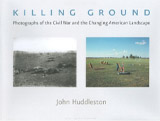Book Review
Killing Ground: Photographs of the Civil War and the Changing American Landscape
By John Huddleston. Baltimore, MD: Johns Hopkins University Press, 2003; 200 pp., photographs, bibliography; cloth $35.00.
These photographs are appeals to peace; they are the most convincing evidence of the tragedy of war. —Francis Trevelyan Miller, 1911 (1) |
 |
Rephotography books feature historic photographs alongside contemporary images taken from the same location. By returning to the street corner or rooftop where past photographers positioned their tripods and exposed their glass plates, rephotographers give us a sense of what was there, what has survived, and what has been lost. These "then and now" works provide insights into the transient nature of the landscapes around us and, by extension, the transient nature of our own time within these landscapes.
Their subjects are predominantly urban. Cities attract the attention of major publishers: Canada's Thunder Bay Press, for instance, publishes more than 35 books on locations from Philadelphia to Phoenix, while local historical societies often assemble similar collections for smaller communities. Books that re-document changes to rural and wilderness landscapes have also appeared, including the recently published Third Views, Second Sights, A Rephotographic Survey of the American West (2004). A number of rephotography books are thematic rather than geographic, addressing significant moments in history such as the Civil War.
In 2002, the Johns Hopkins University Press published Killing Ground: Photographs of the Civil War and the Changing American Landscape by John Huddleston. In the book, Huddleston, a photographer and professor of art at Middlebury College, presents his contemporary color photographs of 62 battlefields next to images taken during the Civil War. Preceding the matched photos, Huddleston offers a brief history of the war and the photographers who documented it, along with an essay describing his methodology and approach to the project. Supplementary materials include a map of the United States noting the battlefields, short descriptions of the battles, biographies of major Civil War photographers, and a bibliography.
Huddleston's work is structured and presented within the tradition of "then and now" books. His 8" x 10" view camera is similar to those used in the 1860s. The author describes his considerable research to identify the "exact physical location of the battlefields" and how he painstakingly arranged to take the photos within days or weeks of the date of battle to maintain consistency of light and foliage. Yet his essay reveals his interest in transcending established rephotography conventions. "I was open," he writes, "to the complexities of the Civil War, to its implications for our present culture and landscape, and to the ways of understanding these issues."
In Killing Ground, understanding is derived, not from the explicit matching of period location and contemporary location, but through content, metaphor, and formal structure. This conceptual approach leads Huddleston away from a literal representation of setting to a search for images that offer intersecting figurative meaning. The author breaks not only with the expectation that his paired photos depict identical locations, but that locations will even be depicted. Historic photos selected for comparison include portraits, engravings, and medical photographs documenting amputee veterans and their limbs—all in an effort to establish cultural, political, economic, and environmental links between the past and present.
Relatively straightforward comparisons between Civil War photos showing the war's effect on 19th-century farms, fields, and cities, and Huddleston's images showing these settings today can be compelling. Ruts left by cannon wheels are mirrored on the adjacent page by the tracks left by earth moving equipment used for clearing sites for new houses; the drainage ditch for a 21st-century subdivision echoes a Confederate trench at Chancellorsville. Sets showing war-ravaged hillsides, cornfields, and clearings alongside a contemporary American landscape cluttered with the detritus of development—abandoned buildings and cars, plastic containers, and mine tailings—highlight the myriad impacts (both radical and incremental) that humans have on their surroundings. The author observes that "In a culture with pronounced respect for military endeavor the expedient treatment of these battlefields does not bode well for lands that have no claim to the special status of 'sacred ground.'" In his photographs, human action disrupts the landscape, and nature slowly conceals and heals the scars.
Less effective are the author's comparisons between a compromised contemporary landscape and the lifeless or maimed bodies of the war's participants. Body and land are inseparable in these pairings. The historic image in one set shows an embalming underway, a hose protruding from the chest of a dead soldier. Apposite, a property boundary marker punctures the hillside of a closed and overgrown strip mine. In several others, portraits of soldiers (some as veterans displaying their wounds, some before they were killed) are matched with contemporary close-ups of battle sites—the muddy bottoms of Beaver Dam Creek, Antietam Creek, and Bull Run.
Rephotography books exhibit a power to connect, compare, and contrast in large part because there is no intermediary. Such works offer little opportunity for individual artistic expression, and commentary is usually limited to accompanying text. The rephotographer is provided a place to put the camera, a direction to point it, a depth of field, an angle of view—even a season and time of day. Because the perspective is unchanged, the line between past and present is easily crossed, and the range of possible conclusions is expansive. In Killing Ground, the author has selected the subject of his photographs within a general location and employs an unlimited assortment of historic images for comparison. Although Huddleston seeks to expand our understanding of the connection between the Civil War and today's environment (political, cultural, natural) by broadening modes of interpretation, the result is actually restrictive. By inserting his perspective of where the correlates exist between past and present, the author leaves the reader little choice but to accept these relationships.
Chad Randl
National Park Service
Note
1. Francis Trevelyan Miller, ed., The Photographic History of the Civil War (New York: Review of Reviews Company, 1911), n.p.
